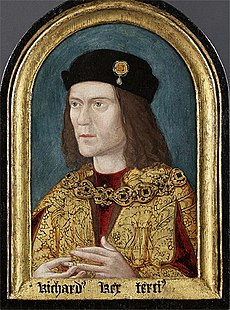Henry II
The Plantagenets.
‘From the devil they came and unto the devil they shall return!’
(A cleric commenting on the Plantagenets.)
When Matilda married Geoffrey of Anjou in 1128, neither of them could have foreseen that their stormy union would produce a dynasty that would rule England for 331 years. The dominance of this family which began 1154 with the coronation of their son, Henry, would only end with the death of Richard III at Bosworth field in 1485.
Richard III

The dynastic name derives from Henry’s father, Geoffrey, whose heraldic symbol of a sprig of yellow bloom was known in Latin as planta genista. The family’s hegemony would see the conquest of Ireland and Wales and the loss of the Angevin empire in France. The dynasty would produce some crusader princes and some great lawmakers. A number of the brood, notably Richard I and Edward I would distinguish themselves as great warrior kings who crowned themselves in military glory.
Richard I Edward I

![]()
 Others such as John I and Edward II , their reputations in tatters, would die in disgrace mourned by very few people. Two monarchs were destined to die on the battlefield, and another two would be secretly put to death in a dark, dank, castle dungeon. The rest would die in bed, including one who was murdered in the comfort of his four poster in the Tower.
Others such as John I and Edward II , their reputations in tatters, would die in disgrace mourned by very few people. Two monarchs were destined to die on the battlefield, and another two would be secretly put to death in a dark, dank, castle dungeon. The rest would die in bed, including one who was murdered in the comfort of his four poster in the Tower.
Henry! The first Plantagenet king!
At his coronation, the Abbey’s bells did ring!
Henry II was crowned by Archbishop Theobold on December 7th 1154 in Westminster Abbey. At twenty one, he was a powerfully built young man with lively grey eyes and a demeanour which exuded a restless energy. An energy which would be used to extremely good effect over the next thirty-five years.
Henry II

‘Cometh the hour, cometh the man’.
Indeed after almost twenty years of anarchy, the country needed an energetic man of ability and forceful character, and they got him. In many respects the second Henry resembled the first. He possessed his grandfather’s determination, administrative abilities and also his sharp political antennae.
Illegitimate baronial authority, I will abolish!
Your illegally built castles, you must demolish!
The young King’s first priority was to re-establish the royal authority which had evaporated in many areas under the weak, chaotic rule of Stephen. Early in his reign, Henry made it clear to the barons that they had to demolish the castles they had built without royal permission. With one notable exception, that of Hugh de Mortimer in Bridgnorth, this objective was achieved quite quickly.
Square keep castle of the type common in the 12th century.

England was not Henry’s sole concern. He was the lord of vast areas of western France. His many French territories included Aquitaine, Brittany, and Normandy for which he did homage to the king of France.
In 1152 Henry married Eleanor of Aquitaine who had formerly been the wife of his nominal overlord, king Louis VII of France. Like his father he had married a woman considerably older than himself. Eleanor was eleven years Henry’s senior.
Eleanor of Aquitaine (1122-1204)

In 1157, Richard, the first of five sons was born. It is ironic that his sons gave Henry more trouble than all of the opponents that he had encountered in the course of his long reign combined. However, that was in the future, so the early years of his reign appeared to be auspicious enough. After the chaos of the previous twenty years, Henry had restored order in England.